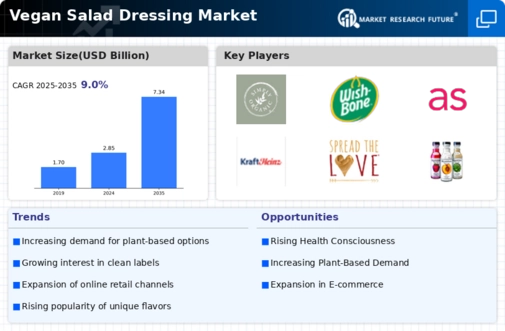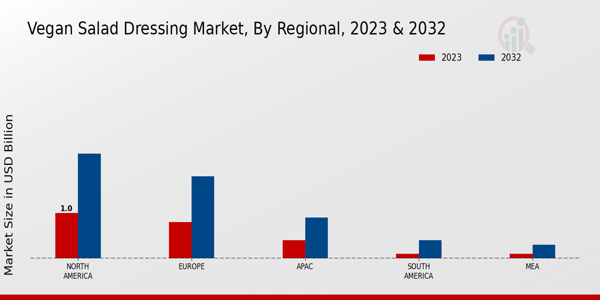Diverse Flavor Profiles
The Global Vegan Salad Dressing Market Industry benefits from the introduction of diverse flavor profiles that cater to a wide range of consumer preferences. As culinary experimentation becomes more prevalent, brands are expanding their offerings beyond traditional flavors to include unique combinations that appeal to adventurous eaters. This diversification is likely to attract a broader audience, contributing to the anticipated compound annual growth rate of 8.98% from 2025 to 2035. By incorporating global flavors and innovative ingredients, companies can tap into emerging trends and enhance consumer engagement, thus driving market growth.
Market Growth Projections
Rising Health Consciousness
The Global Vegan Salad Dressing Market Industry is witnessing a surge in demand driven by an increasing awareness of health and wellness among consumers. As individuals become more conscious of their dietary choices, the preference for plant-based products, including vegan salad dressings, is on the rise. This shift is reflected in the projected market value of 2.85 USD Billion in 2024, indicating a robust interest in healthier alternatives. Moreover, the trend towards clean label products, which are perceived as healthier, further propels this market. Consumers are actively seeking dressings that are free from artificial ingredients, thus enhancing the appeal of vegan options.
Increased Availability in Retail Channels
The expansion of retail channels significantly influences the Global Vegan Salad Dressing Market Industry. With the growing popularity of vegan products, retailers are increasingly stocking a variety of vegan salad dressings, making them more accessible to consumers. This trend is evident in both brick-and-mortar stores and online platforms, where the availability of vegan options is on the rise. Enhanced distribution strategies and partnerships with grocery chains facilitate this growth, allowing consumers to easily find and purchase these products. As a result, the market is poised for substantial growth, aligning with the overall trend of increasing plant-based product availability.
Sustainability and Environmental Concerns
Sustainability plays a pivotal role in shaping the Global Vegan Salad Dressing Market Industry. As environmental concerns escalate, consumers are increasingly opting for products that align with their values regarding sustainability. Vegan salad dressings, often produced with lower carbon footprints compared to traditional dressings, resonate with eco-conscious consumers. This trend is expected to contribute to the market's growth, with projections indicating a rise to 7.34 USD Billion by 2035. The emphasis on sustainable sourcing and production methods not only attracts environmentally aware consumers but also encourages brands to innovate, thereby enhancing the overall market landscape.
Health Benefits of Plant-Based Ingredients
The health benefits associated with plant-based ingredients are a significant driver for the Global Vegan Salad Dressing Market Industry. Ingredients such as nuts, seeds, and avocados, commonly found in vegan dressings, are rich in essential nutrients and healthy fats. This nutritional profile appeals to health-conscious consumers who are increasingly seeking alternatives that support their dietary goals. As the market evolves, brands are likely to emphasize these health benefits in their marketing strategies, further enhancing consumer interest. The growing recognition of the advantages of plant-based diets contributes to the overall expansion of the market.
























